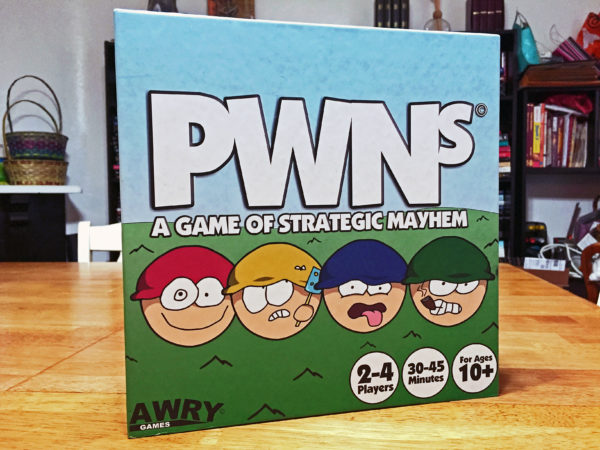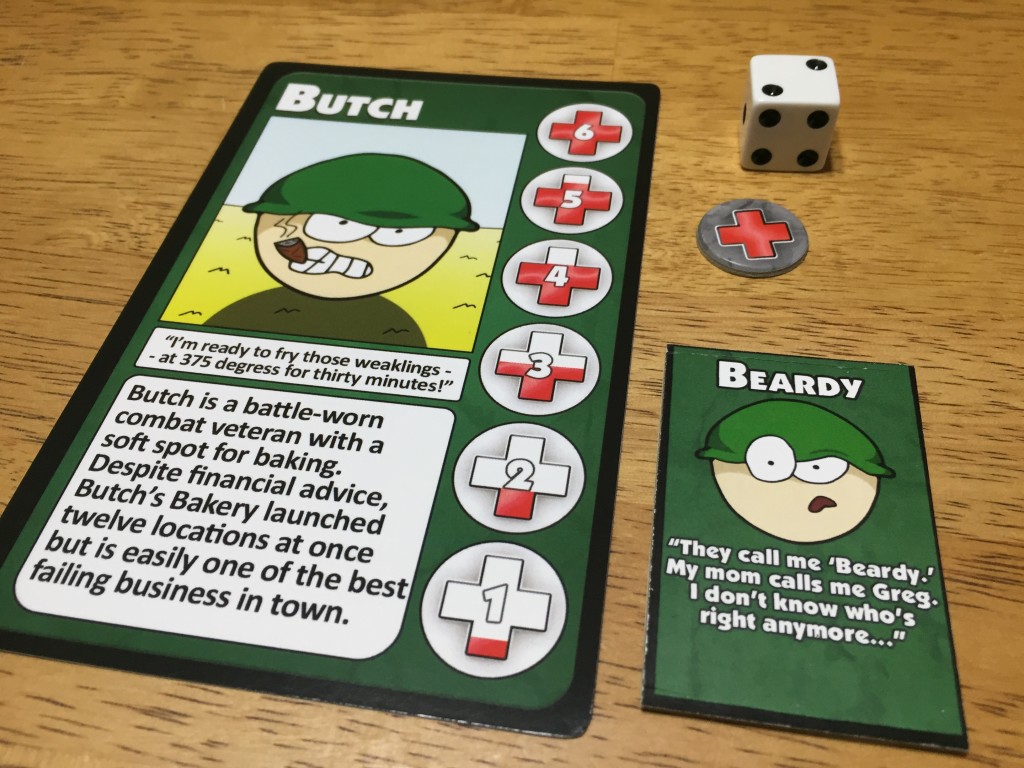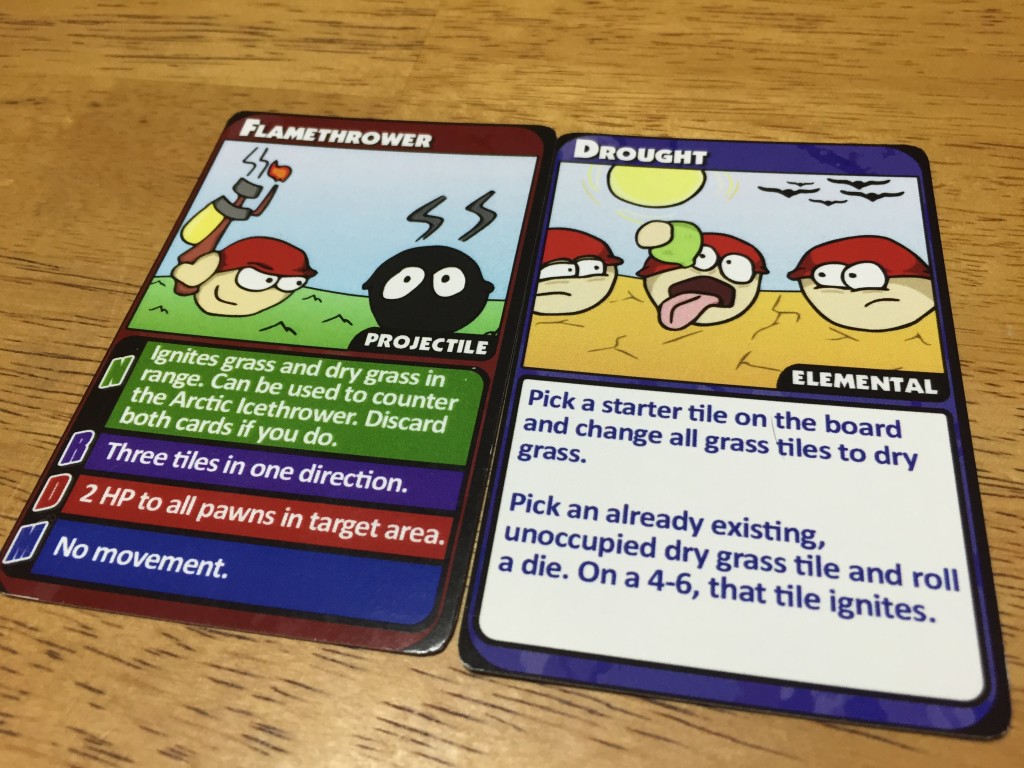I can’t keep up with kids today anymore. I remember a day when being “radical” or “gnarly” was a thing…now I have to ask my family (or sometimes Google) when I come across a word that you’d usually not find in the dictionary. As fortune would have it, I’m a gamer…meaning I know all about being “pwned”. For those of you not of the leetspeak, it’s generally used as a verb in place of the word “owned”. So if you absolutely humiliated someone in a game or event, then you can have said to have “pwned” them. Of course you knew that already, which is “dope” (either that or “cray-cray”, I have to go check Google again).

Today, we’ll be using it as a noun…that is, as a type of soldier unit that can be found in the 2-4 player board game “PWNs”. It’s currently seeking funding through the Kickstarter process though based on what I’ve played, you’re essentially trying to be the last player standing by strategically placing your PWNs around the board and playing cards at just the right moment. Special thanks to Game Creator Ryan Boyle from Awry Games for providing me with a prototype for preview purposes. It’s important to stress that prototypes aren’t generally reflective of the final product, meaning that the components and rules seen below are subject to change.
The game comes with 1 PWNs board, 72 cards, 60 terrain tiles, 16 PWNs pieces, 16 character cards, 16 plastic character stands, 16 health tokens, 5 starter tiles, a six-sided die, and a rules booklet. To set up the game, you’ll draft a team of four PWNs of a particular color. You’ll want to take the matching character cards / tokens and place a health counter on “5” for each. Four 4×4 starter tiles are chosen at random and placed on the board. Once done, a player can place their four PWNs anywhere within their starting zone (the spaces of their color). Each player will then receive a number of cards from the shuffled deck, the hand limit being determined by the number of players. For example, in a two player game each player gets five cards. The first player is chosen via a die roll.
The game itself is broken up over a series of rounds. Completing a full round occurs when each player has taken a turn (starting with the first player). This is an important distinction, as some card effects last for a certain number of turns or rounds. A player’s turn is broken up into three phases:
1. Movement – The player may move their PWNs a total of three tiles split any way they want. For example, they can move three of their units one space or one of their units three spaces. PWNs do not move diagonally and take damage when moving through hazards. Moving onto an occupied tile causes a collision. Collisions generally involve both units losing HP and the bumped player moving in the direction bumped, but there are exceptions. Players need not use all three movement points if they don’t want to.
2. Action – The player may play one attack or elemental card, if they have one. If they caused a collision during the movement phase, then this phase is skipped.
3. Health – The player may play a health card to heal one or more PWNs, assuming they have one in their hand.

At the end of their turn a player draws up (or discards down) to their hand limit. The hand limit will change throughout the game as players are eliminated. When a PWN loses all of its health, it is removed from the board. When a player loses all of their PWNs, they are eliminated from the game. The person left standing when the smoke clears, wins!
As you can see, turns are relatively simple to execute. The terrain and card effects, on the other hand, really invite the player to think outside the box. Speaking of cards, there are actually four types (not three as you may have gathered from the above). There are attack, elemental, reaction, and health cards. Reaction cards, the card I didn’t talk about above, are played on someone else’s turn in response to something.
Action cards come in three flavors: Combat, Projectile, and Special. Combat usually signifies hand to hand while projectile usually involves a ranged attack. An attack that doesn’t fit under either category is special. In most case, a card will include a particular format. The green notes section tells you about the card, the pink range section tells you how far & in what direction, the red damage section tells you who is effected & how much HP they lose, and the purple movement section tells you who will move & how far. Some cards ignore this format, in which case they player simply follows the text instructions. Elemental cards are designed to affect both the board terrain and PWNs, while the use of health cards are obvious.

“PWNs” strikes me as the kind of strategic game you can play with someone who wants a strategic experience but not the headaches that usually come with it. I have plenty of Euro games in my collection that can last two hours and require you to be constantly thinking as you play. “PWNs” is light enough to where you can get your fill rather quickly, though the chaotic mess of a four player game is equally as attractive. For beginners, I recommend starting without any special terrain tiles so that you can get used to what the cards do without also factoring in terrain effects. You won’t capture the full experience this way, but it’s a great way to ease casual gamers into the game without overwhelming them with too much information.
I personally liked “PWNs” as it reminds me of those simpler turn-based grid-based army games I play on the PC…only here you can actually see the look on your opponent’s face when you blast their PWN with a water hose and cause a chain of really nasty collisions. Anyone who enjoys light and chaotic war games would do well to check out this project on Kickstarter.
—
Kickstarter: https://www.kickstarter.com/projects/awrygames/pwns-a-game-of-strategic-mayhem-0
Facebook: https://www.facebook.com/awrypwns
Twitter: https://twitter.com/AwryPWNs
Website: http://awrycorp.com/pwns/
